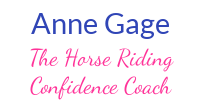by Anne Gage of Confident Horsemanship
I recently read an article by a Well Known Clinician in which she was offering tips for training a horse that did not want to go out on the trail alone. I agreed with her on several points:
- The reason this is such a common problem – horses are reluctant to leave the security they feel with their herd mates.
- That it would not be an overnight fix, but would take at least several weeks of training to resolve.
- That the work would have the benefits of making the horse safer and more willing.
- That ground work must be the starting point of the re-training.
- That the horse needs to have his attention on you (the trainer/rider) rather than on his herd or distractions in the environment.
But, I disagreed with the Well Known Clinician’s instructions to:
- “demand respect”,
- not let him “get away with” small disobediences, and
- “make him walk through” things that he is avoiding.
The words we use affect our behaviour.
What feelings and thoughts come to your mind when you hear the word “demand” or the phrase “don’t let him get away with …” or “make him do it”? What comes to my mind is aggression, force, conflict. There is a winner and a loser. It feels dictatorial and unsympathetic to the needs and feelings of the other party – whether that is a human or a horse. This way of thinking, in my mind, sets up a “master/servant” type of relationship.
When I work with horses, my aim is to create a willing partnership based on respect, trust and cooperation. These elements are much stronger when they are earned rather than demanded.
Respect is earned by having clear, consistent and appropriate boundaries.
Trust is earned by paying attention to what the horse needs and then giving him that.
Confidence is built by decreasing his stress and helping him to feel calm and safe.
I want the horse to choose to follow me not because he is afraid of me, but because he feels safe with me – mentally as well as physically.
Behaviour is communication. If the horse is not behaving or responding the way I would like him to, I don’t consider that as “disobedience”.
Rather than “not letting him get away with small disobediences”, I consider why the horse has a certain behaviour. For example, if he won’t stand still for mounting I consider possible reasons. Is he experiencing pain, anxiety or fear? When I address the reason and give the horse what he needs to be calm and relaxed, then he will be able and willing to stand quietly.
Rather than “making him walk through things he is avoiding”, I consider his perspective as a flight, prey animal. If he is concerned about a particular object, I will work with him in his “comfort zone” and gradually expand that area while I help to keep him in a calm, level frame. In this way, I build his trust in me and his confidence increases.
When you earn your horse’s respect and trust, he will become more willing and confident – naturally. You horse will feel safe, calm and relaxed whenever he is with you – even when he is away from his herd mates.
Click here to watch a short video (6.29 min) to see how I apply these principles when working with a horse in-hand (leading in contact) to build trust, respect and confidence.
There are lots more practical and in depth tips on improving your Confidence and your Partnership with your horse in my book “Confident Rider, Confident Horse: Build Your Confidence While Improving Your Partnership with Your Horse from the Ground to the Saddle”. Click here to order your copy today! [vc_row][vc_column width=”1/1″][vc_separator color=”grey” style=”” el_width=””][/vc_column][/vc_row][vc_row][vc_column width=”1/4″][/vc_column][/vc_row] Like this article? Share it with a friend, Tweet it, Pin it or post it on Facebook.[vc_row][vc_column width=”1/4″][vc_tweetmeme type=”horizontal”][/vc_column][vc_column width=”1/4″][vc_facebook type=”button_count”][/vc_column][vc_column width=”1/4″][vc_pinterest type=””][/vc_column][vc_column width=”1/4″][vc_googleplus type=”tall” annotation=”inline”][/vc_column][/vc_row]Interested in hosting a Confident Horsemanship Clinic at your location? Click here for information.
You’re welcome to use this article in your blog or newsletter as long as you notify me and give my credit information. ~ Written by Anne Gage of Confident Horsemanship (www.ConfidentHorsemanship.com)[vc_row][vc_column width=”1/1″][vc_separator color=”grey” style=”” el_width=””][/vc_column][/vc_row]Anne Gage started Confident Horsemanship in 2002 after suffering the loss of her confidence for riding. As she worked on regaining her confidence she discovered that many horse women were suffering in silence – thinking they were alone. Anne works with horse women to regain their CONFIDENCE and PASSION for riding while building a PARTNERSHIP with their horses that they deserve.
